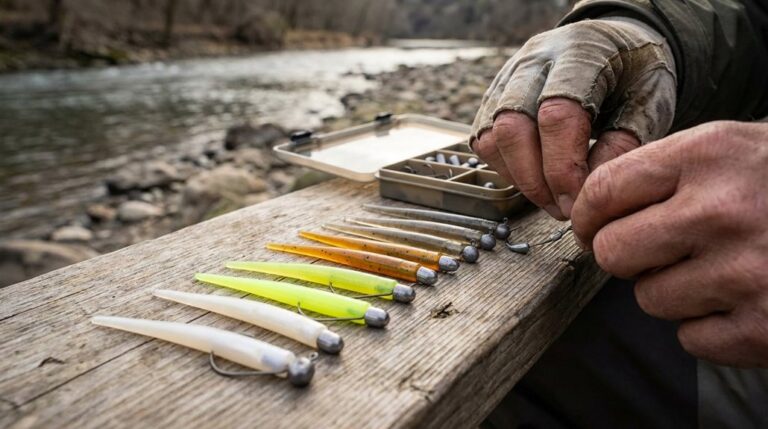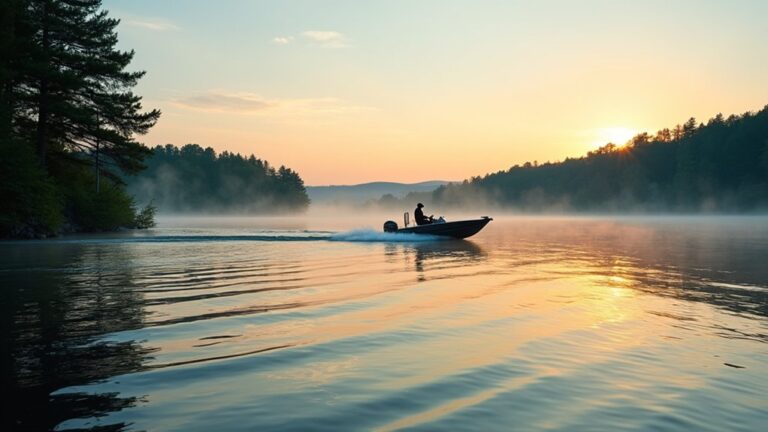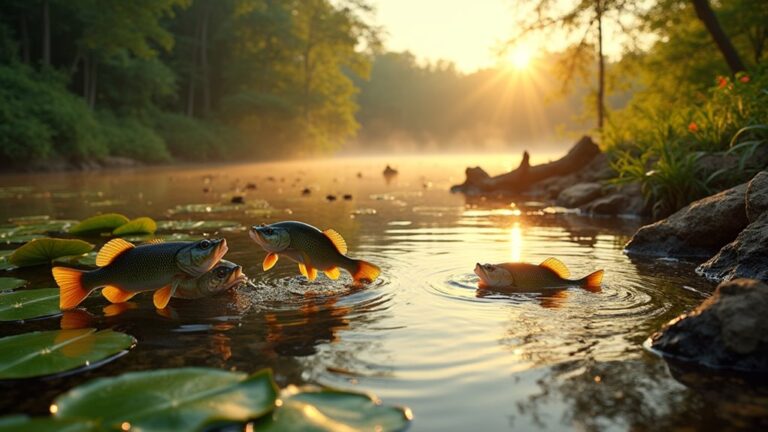To catch trout successfully, know their habitats and adapt your approach. Different trout species thrive in various conditions, so research where they live. Use a lightweight, 7-foot rod paired with a spinning reel and 4-8 lb test line for better sensitivity. Experiment with bait like nightcrawlers or PowerBait and lure options like inline spinners. Employ effective techniques such as casting slightly upriver to let your bait drift naturally. Timing is essential; early mornings and late evenings are prime fishing times. Understanding these tips will enhance your experience, and there's so much more to explore that could increase your success.
Key Takeaways
- Choose the right gear: Use a lightweight 7-foot spinning rod and a matching reel for better casting control and sensitivity to bites.
- Select appropriate bait: Utilize PowerBait for stocked trout or live nightcrawlers for a natural scent that attracts various species effectively.
- Adapt your fishing techniques: Experiment with different retrieval speeds and methods to mimic prey behavior and increase your chances of a strike.
- Focus on seasonal patterns: Plan your fishing trips during spring and fall when trout are most active, adjusting techniques based on seasonal changes.
- Target prime locations: Cast spinners or spoons slightly upriver and focus on areas behind rocks and deeper pools where trout tend to hide.
Types of Trout and Their Habitats
When it comes to trout fishing, do you know which species to target based on their habitats? Understanding the different types of trout and their preferred environments can greatly improve your success on the water.
Rainbow trout thrive in cold, clear rivers and streams, typically preferring temperatures between 45-60°F. They're the most widely stocked species in Oregon, making them a popular target.
Brown trout, on the other hand, are known for their size and tenacity. You can find them in various rivers, often tolerating slightly warmer streams.
Cutthroat trout, identifiable by their striking red-orange slashes, are native to many coastal streams. They inhabit diverse habitats, including beaver ponds, making them an exciting option for anglers.
If you're fishing in high mountain lakes or tributaries, keep an eye out for brook trout. These smaller fish usually average 5 to 7 inches and prefer colder waters.
No matter which trout species you pursue, knowing their habitats can help you choose the right fishing techniques.
Focus on locating aquatic insects in these areas, as they play a vital role in attracting trout. Happy fishing!
Essential Trout Fishing Gear
Having the right gear can make all the difference in your trout fishing experience. Start with a lightweight 7-foot spinning rod paired with a spinning reel and 4-8 lb test fluorocarbon line. This setup allows for better casting control and sensitivity to detect bites. For bait, PowerBait works wonders for stocked trout, while nightcrawlers appeal to all trout species due to their natural movement and scent.
Your crucial tackle should cover various techniques and conditions. Here's a quick reference table to help you organize your gear:
| Tackle Type | Gear Description | Purpose |
|---|---|---|
| Spinners | Small, rotating lures | Attracts trout visually |
| Bait Hooks | Hooks for worms or PowerBait | Effective for live bait |
| Assorted Flies | Different patterns and sizes | Target trout in fly fishing |
If you're into fly fishing, don't forget a 5-weight fly rod, matching reel, tapered leaders, and tippet spools. This gear will help you effectively target trout in their natural habitats. Always be prepared with a variety of tackle to enhance your chances of success!
Effective Fishing Techniques
Mastering effective fishing techniques is essential for a successful trout fishing experience. Start by using a long rod, around 7 feet, with ultra-light action. This setup effectively absorbs the energy of trout during fights and enhances your casting distance.
When it comes to retrieve techniques, don't hesitate to experiment. Steady retrieving, slow-rolling, or drop-bait methods can mimic prey behavior, increasing your chances of a strike.
For river fishing, cast spinners or spoons slightly upriver to allow for a natural drift. Target areas behind rocks and in deeper pools where trout often hide. If you're bait fishing, using bobbers can be exceptionally helpful. They track the movement of your bait, especially in slower pools, ensuring it stays near the bottom where trout are most active.
Keep in mind the seasonal changes, as trout behavior varies throughout the year. They tend to be more active in spring and fall, while summer fishing is best during the early morning and late evening hours.
Best Lures for Trout Fishing
Choosing the right lures can greatly boost your trout fishing success. The best lures for trout fishing often depend on the conditions and your target species. Here are some effective options to contemplate:
- Inline Spinners: Brands like Blue Fox and Panther Martin create enticing flash and vibration, perfect for attracting trout in lakes and rivers.
- Soft Plastic Worms: Utilizing curly-tail grubs or tubes, these lures mimic zooplankton, making them versatile for various water conditions and great for catching rainbows.
- Live Bait: Nothing beats the effectiveness of live worms. Use them beneath a bobber or on the bottom in slower-moving waters to maximize your chances.
- Flashy Spoons: These lures create visual attraction in the water column, provoking strikes from trout, especially in colder weather.
For larger trout, crankbaits sized up to half the length of the fish can be particularly effective when presented in their natural habitats.
Pair these lures with your spinning reel, and you'll be well on your way to a successful day on the water!
Proven Fishing Tactics
When targeting trout, employing proven fishing tactics can make a significant difference in your success. One effective method for fishing for trout in rivers and streams is casting spinners or spoons slightly upriver. This allows your bait to drift naturally into prime locations, like behind rocks and undercut banks, where trout tend to hide.
In lakes and ponds, consider suspending your bait under a bobber. Using worms or PowerBait with lead weights can be particularly effective for attracting trout in deeper waters.
Adjust your retrieval speed and vary the sinking time of your lures to mimic the movement of prey, especially during active feeding periods.
Early morning and late evening are prime times for trout fishing, as the cooler temperatures encourage trout to be more active.
Keep in mind that utilizing light tackle—like a 4-6 lb test monofilament line—can enhance your bait presentation and increase your chances of hooking sensitive trout species.
Simplifying Your Fishing Experience
Fishing doesn't have to be complicated to be enjoyable and rewarding. By simplifying your approach, you can easily find trout and have great fishing experiences. Here are four crucial tips to get you started:
- Choose the Right Location: Look for accessible streams and ponds known for stocked trout. Calm water is often ideal for a successful catch.
- Select Your Bait: Use PowerBait or live worms, placing your bait along the bottom. These common trout favorites can greatly increase your chances of reeling in fish.
- Keep It Simple: Stick to basic fishing gear and don't overthink your setup. A few effective fishing lures can make all the difference, especially when you experiment according to local conditions.
- Get Local Insights: Connect with fellow anglers for tips on where to find trout. Local knowledge can save you time and enhance your fishing experience.
Conclusion
To sum up, trout fishing can be an incredibly rewarding experience when you know what you're doing. Did you know that over 70% of anglers catch their limit when using the right techniques and gear? By understanding the types of trout, utilizing effective fishing techniques, and selecting the best lures, you can greatly increase your chances of success. So gear up, head out, and enjoy the thrill of landing that perfect trout—it's all within your reach!



